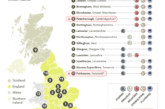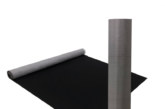New Guide to Building Materials and the Environment helps built environment professionals pave the way to Net Zero Carbon future.
A new and completely revised edition of the RIBA award-winning Guide to Building Materials and the Environment has been launched by AJ100 architecture practice Stephen George + Partners in collaboration with the GreenSpec website in response to the building industry’s push towards Net Zero Carbon and the perceived lack of clear, independent, rational information on how to achieve it.
Authored by Chris Halligan, Chartered Architectural Technologist at NPS Leeds, the latest and extensively re-written edition of the guide is available free of charge and provides built environment professionals, self-builders and interested students with a transparently sourced, consistent and fully explained road map to various material options, from the traditional to the cutting-edge, and lays out how sustainable some “green” materials really are in their production, use and eventual disposal.
The push for Net Zero Carbon has seen increased momentum in the last few years with governments, companies and individuals looking to find ways to reduce their carbon footprint, reduce carbon emissions and keep global warming to 1.5˚C or below. When it comes to Net Zero Carbon buildings, the focus from the industry has primarily been on reducing operational energy, mainly from heating, cooling and electricity use.
However, in the UK, the operation of buildings accounts for around 30% of emissions1, whilst the embodied emissions from construction can account for up to half of the carbon impacts associated with the building over its lifecycle2. Some 11% of global carbon emissions stem from the extraction, manufacture and transport of the materials used in the building3. This embodied carbon, sometimes known as “upfront carbon” as it contains carbon emitted before the building is ever operational, needs to be a target for architects and specifiers in the design and delivery of new projects.
Says Chris Halligan MCIAT, Co-creator of the original guide and Author of the new, completely revised edition: “While Net Zero forms the backbone of UK Government climate policy, there is still no UK legislation covering the embodied carbon or general sustainability of materials. Most of the focus continues to be on operational energy. This does not mean it isn’t being addressed by the industry, but the lack of information and the often spurious sustainable credentials of materials by unscrupulous marketeers can make the process difficult to navigate.
“The only way to steer a successful course is knowledge. Hence the need for this newly updated version of the Guide to Building Materials and the Environment. Without truly understanding the impact of our actions, through an intelligent selection of materials which will not damage the environment, can we ever hope to achieve the sustainable solutions rapidly proving to be essential.”
The new edition of the guide has seen almost all the original materials re-assessed. The construction industry has changed significantly in the thirteen years since the original Guide was published, with some of the materials that were expected to have a great future failing to make a mark and new materials — and new ways of making old materials — coming into the spotlight.
The guide contains a short overview and explanation of the range of terms associated with sustainable building, with interactive links to external sources of further information. An extensive summary of materials and products, from asphalt and steel to bamboo and earth, living roofs to phase change materials, provides an insight into the environmental impact of their production, use and eventual disposal, supported by data sheets with guidance on their advantages and disadvantages, practical considerations and sustainable alternatives.
James Nicholls, Managing Partner at SGP concluded: “Long before it became an international headline, SGP was challenging the status quo and looking for more sustainable options for architects. We are proud to have been accepted for Planet Mark accreditation in 2019, and our most recent adventure has been to create “Better Buildings”, a suite of resources for school children to get them thinking about sustainable materials.
“The landscape of sustainable development is complex and changing, but we believe the data and ideas contained in this fully revised Guide to Building Materials and the Environment will help everyone in the construction industry, from architects and contractors to developers and private self-builders, plot their own route through the maze of sustainable materials, and deliver building that won’t cost the earth.”
To download a free copy of the Guide to Building Materials and the Environment, please visit: https://www.stephengeorge.co.uk/a-guide-to-building-materials-and-the-environment/
Footnotes:
- Committee on Climate Change (2018). Reducing UK emissions – 2018 Progress Report to Parliament.
- Royal Institution of Chartered Surveyors (RICS) (2017). Whole life carbon assessment for the built environment RICS professional statement, UK.
- World Green Building Council Bringing Embodied Carbon Upfront report (https://worldgbc.org/advancing-net-zero/embodied-carbon/










